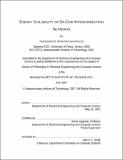| dc.contributor.advisor | Anant Agarwal. | en_US |
| dc.contributor.author | Konstantakopoulos, Theodoros K., 1977- | en_US |
| dc.contributor.other | Massachusetts Institute of Technology. Dept. of Electrical Engineering and Computer Science. | en_US |
| dc.date.accessioned | 2008-02-27T20:37:51Z | |
| dc.date.available | 2008-02-27T20:37:51Z | |
| dc.date.copyright | 2007 | en_US |
| dc.date.issued | 2007 | en_US |
| dc.identifier.uri | http://hdl.handle.net/1721.1/40315 | |
| dc.description | Thesis (Ph. D.)--Massachusetts Institute of Technology, Dept. of Electrical Engineering and Computer Science, 2007. | en_US |
| dc.description | This electronic version was submitted by the student author. The certified thesis is available in the Institute Archives and Special Collections. | en_US |
| dc.description | Page 198 blank. | en_US |
| dc.description | Includes bibliographical references (p. 191-197). | en_US |
| dc.description.abstract | On-chip interconnection networks (OCN) such as point-to-point networks and buses form the communication backbone in multiprocessor systems-on-a-chip, multicore processors, and tiled processors. OCNs consume significant portions of a chip's energy budget, so their energy analysis early in the design cycle becomes important for architectural design decisions. Although innumerable studies have examined OCN implementation and performance, there have been few energy analysis studies. This thesis develops an analytical framework for energy estimation in OCNs, for any given topology and arbitrary communication patterns, and presents OCN energy results based on both analytical communication models and real network traces from applications running on a tiled multicore processor. This thesis is the first work to address communication locality in analyzing multicore interconnect energy and to use real multicore interconnect traces extensively. The thesis compares the energy performance of point-to-point networks with buses for varying degrees of communication locality. The model accounts for wire length, switch energy, and network contention. This work is the first to examine network contention from the energy standpoint. | en_US |
| dc.description.abstract | (cont.) The thesis presents a detailed analysis of the energy costs of a switch and shows that the estimated values for channel energy, switch control logic energy, and switch queue buffer energy are 34.5pJ, 17pJ, and 12pJ, respectively. The results suggest that a one-dimensional point-to-point network results in approximately 66% energy savings over a bus for 16 or more processors, while a two-dimensional network saves over 82%, when the processors communicate with each other with equal likelihood. The savings increase with locality. Analysis of the effect of contention on OCNs for the Raw tiled microprocessor reports a maximum energy overhead of 23% due to resource contention in the interconnection network. | en_US |
| dc.description.statementofresponsibility | by Theodoros K. Konstantakopoulos. | en_US |
| dc.format.extent | 198 p. | en_US |
| dc.language.iso | eng | en_US |
| dc.publisher | Massachusetts Institute of Technology | en_US |
| dc.rights | M.I.T. theses are protected by copyright. They may be viewed from this source for any purpose, but reproduction or distribution in any format is prohibited without written permission. See provided URL for inquiries about permission. | en_US |
| dc.rights.uri | http://dspace.mit.edu/handle/1721.1/7582 | |
| dc.subject | Electrical Engineering and Computer Science. | en_US |
| dc.title | Energy scalability of on-chip interconnection networks | en_US |
| dc.title.alternative | Energy scalability of OCN | en_US |
| dc.type | Thesis | en_US |
| dc.description.degree | Ph.D. | en_US |
| dc.contributor.department | Massachusetts Institute of Technology. Department of Electrical Engineering and Computer Science | |
| dc.identifier.oclc | 191824104 | en_US |
